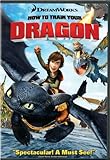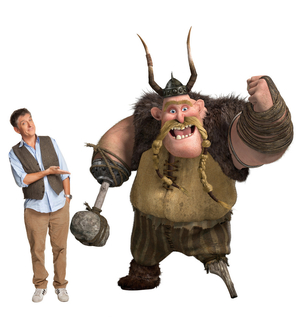 Dragons with a penchant for chewing off limbs and burning down houses plague the Viking village of Berk in How to Train Your Dragon. The first amputee character introduced is Gobber, a burly veteran; in peacetime he’s the village blacksmith and informal prosthetist, in wartime (which is pretty much all the time) he’s the chief’s right-hand man, and teaches Viking striplings their way around a dragon.
Dragons with a penchant for chewing off limbs and burning down houses plague the Viking village of Berk in How to Train Your Dragon. The first amputee character introduced is Gobber, a burly veteran; in peacetime he’s the village blacksmith and informal prosthetist, in wartime (which is pretty much all the time) he’s the chief’s right-hand man, and teaches Viking striplings their way around a dragon.
Gobber likes to tell his drinking buddies about the time he had his hand in a dragon’s mouth, boasting that he could have ripped out its heart, but the dragon decided to eat it before he had a chance. That dragon must have found him tasty and spread the word, according to Gobber, because another dragon ate his leg in a later battle. Fortunately Gobber could devise his own prosthetics with interchangeable attachments made of leather and iron, with the help of his apprentice Hiccup.
Hiccup, the scrawny son of Stoick the chief, has been deemed unsuitable for dragon-fighting duty by the rest of the village. He tries building novel projectile weapons to compensate for his apparent weakness, but when one actually downs a dragon mid-flight he doesn’t have the heart to finish the job. Instead, he brings food to the injured dragon and the two begin observing each other.
Realizing the dragon he has mistakenly dubbed Toothless can’t fly in a straight line without the stabilizing fin on its tail, Hiccup devises a foldable one. He rigs up a mechanism to control it with his foot during flight, and the two nearly get themselves killed, and discovered, practicing. Hiccup convinces Toothless to bring him along on a trip to the volcano the dragons call home, and discovers they’re being oppressed by a much larger dragon who requires regular feedings of sheep, cattle, and people to remain quiescent.
Stoick gets wind of the nest and decides to launch an all-out attack. Hiccup, Toothless (and several other newly-trained dragons) join the melee, but are knocked unconscious by a fall from great height. He wakes up back in his hut to discover that he’s lost a leg. A momentary look of resignation crosses Hiccup’s face, then he gets out of bed to practice walking on the prosthetic that Gobber has already fashioned and put on for him. Supported by Toothless, Hiccup walks outside to the acclaim of the village, tease Gobber about his workmanship, and discover that his new prosthetic easily interfaces with the controls for Toothless’ prosthetic tail fin.
Based on the book How to Train Your Dragon Book 1, this movie must have offered many opportunities for merchandising tie-ins, such as the Adult/Child Costume Accessory Viking Helmet and Horns, the How To Train Your Dragon Movie Mini Talking Plush Night Fury, and of course the How to Train Your Dragon Milk Chocolate Dragon Eggs. Sadly, they didn’t think to market any branded leather-and-iron Viking prosthetic limbs. And even more sadly, the producers of the How To Train Your Dragon video game, set after the events in the movie, did not see fit to depict Hiccup as an amputee.
The How to Train Your Dragon DVD is properly captioned and has an audio description track, and even the DVD extras are subtitled. Kudos to Dreamworks for their accessibility features!


